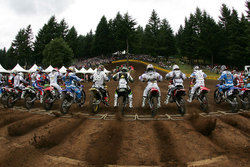The simple rules of directional tyres are, on a road bike, if you have directional tyres the arrow must point in the direction the tyre is going to rotate for the rear, front tyre the directional arrow can point either with the rotation or against, in wet or icy conditions though reverse it as you get slightly better grip when it comes to braking and not so likley to slip out from under you, but could lock up easier and slide out so its a gamble what you do, MTBs rear as a road bike and front tyre arrow should be pointing in the opposite direction of rotation, so your rear tyre grips better to propel you forward from the pedaling action but with your front reversed you get a better braking effect on rough surfaces. If it is a MTB and the emphasis is on fast downhill, fit both tyres in reverse as power transfer is not a priority but you can obtain maximum braking effect from your tyres.
Schwalbe MTB tyres can come with with the tyre marked up with two arrows, one arrow relates to fitting on the front and the other for the rear
Schwalbe MTB tyres can come with with the tyre marked up with two arrows, one arrow relates to fitting on the front and the other for the rear


